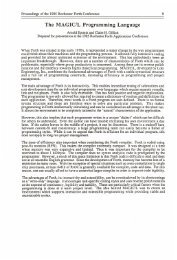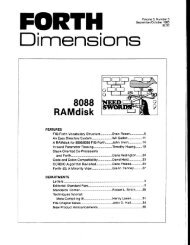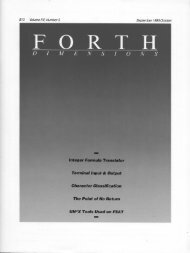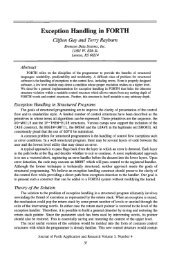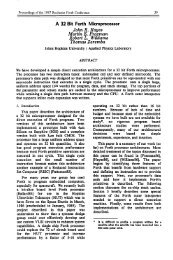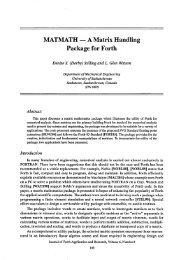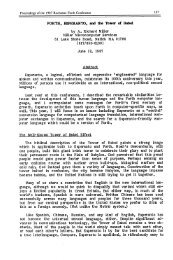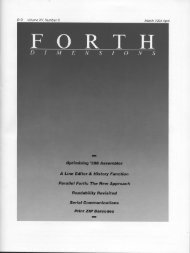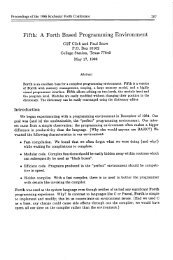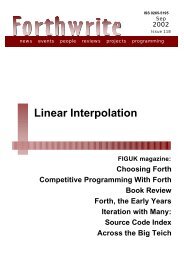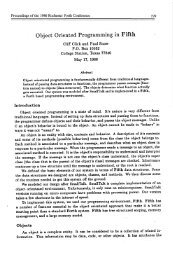1 - Forth Interest Group
1 - Forth Interest Group
1 - Forth Interest Group
You also want an ePaper? Increase the reach of your titles
YUMPU automatically turns print PDFs into web optimized ePapers that Google loves.
In contrast, some models (let's call them Java-like) allow<br />
sending only those selectors to an object that were<br />
explicitly defined for the class of the object or its ancestor<br />
classes. Some also have multiple inheritance or Java-like<br />
interfaces.<br />
In practice, you can program the same things with the<br />
Smalltalk-like and Java-like models. In the Java-like models,<br />
you have to define the selector in a common ancestor class (or<br />
common interface) of all objects that use the selector. If you<br />
fail to do this, and send a message to an object for which the<br />
selector was not defined, the result in a straightforward implementation<br />
of a Java-like model is a crash or the invocation of<br />
an unrelated method; in contrast, with a Smalltalk-like model,<br />
you get a run-time error message not understood.<br />
Concerning implementation, a Java-like model can be<br />
implemented easily and efficiently, using a technique that<br />
C++ implementors call virtual function tables. For a Smalltalklike<br />
model on an interactive system like <strong>Forth</strong>, using virtual<br />
function tables is much harder.* Indeed, as far as I know, no<br />
Smalltalk-like <strong>Forth</strong> extension uses virtual function tables;<br />
they all use searching methods that are significantly slower.<br />
Proponents of Smalltalk-like models argue that most selector<br />
lookups can be resolved at compile time, eliminating<br />
the searching overhead. However, studies of programs written<br />
in full object-oriented style (in other languages) show that<br />
message sends occur every 60 instructions (median), and even<br />
complex analysis algorithms leave a significant number of<br />
them unresolved (usually because the message send actually<br />
does invoke different methods at run time)."<br />
We can make the Neon model standard (after all, we can<br />
still implement the others in plain <strong>Forth</strong>), but if we do so, we<br />
should be aware of its properties.<br />
References<br />
1. John R. Hayes. "User-defined local variable syntax with<br />
I ANS <strong>Forth</strong>." Six<strong>Forth</strong> Newsletter, 4 no. 2, 1992.<br />
I<br />
2. Bradford J. Rodriguez and W.F.S. Poehlman. "A survey of object-oriented<br />
<strong>Forth</strong>s." SIGPLANNotices, pages 39-42, April 1996.<br />
3. Andrew McKewan. "Object-oriented programming in ANS<br />
<strong>Forth</strong>." <strong>Forth</strong> Dimensions, March-April 1997.<br />
4. Jan Vitek and R. Nigel Horspool. "Compact dispatch tables<br />
for dynamically typed object oriented languages." In Tibor<br />
Gyim6thy, editor, Compiler Construction (CC '96), pages 309-<br />
325, Linkoping,<br />
- - 1996. Springer - -<br />
LNCS 1060.<br />
5. ~ mer ~iwan, J. Eliot B. Moss, and Kathryn S. McKinley.<br />
"Simple and effective analysis of statically-typed object-oriented<br />
~ro~rams." conference on Object-Oriented Programming System,<br />
Languages &Applications (OOPSLA '96, pages 292-305,1996.<br />
Continued from page 9<br />
or decreasing the size of a running transputer <strong>Forth</strong> system).<br />
Saving a modified transputer <strong>Forth</strong> system to the current<br />
DOS drive via SAVE-SYSTEM TFORTH. FYS.<br />
Saving a modified transputer <strong>Forth</strong> multisystem to the current<br />
DOS drive via SAVE-MULTI TFORTH. FYM .<br />
On-line help for all vocabularies: HELP .<br />
Rich documentation in various .doc files.<br />
Saving any transputer <strong>Forth</strong> RAM area as a DOS file.<br />
Loading the contents of any DOS file to any transputer<br />
<strong>Forth</strong> RAM area.<br />
Breaking a transputer <strong>Forth</strong> program any time via [ Escl ,<br />
thereby jumping to server in host ...<br />
... resuming such a program via START...<br />
... or immediately exit to DOS BYE-FOR-D3S or[ ESCI BYE.<br />
Resuming transputer <strong>Forth</strong> operation from DOS level via<br />
TRESUME (DOS batch file; data stack contents are preserved).<br />
New loading of the transputer <strong>Forth</strong> system via LOAD-FTP<br />
(the data stack contents get lost).<br />
New loading of a previously saved multisystem via LOAD-<br />
FTP M (the data stack contents get lost).<br />
DuMPing with screen-forward and screen-back option on<br />
keystroke.<br />
LEARN setup procedure binds the on-line help system to<br />
the respective CONTEXT vocabulary; LEARN comes with Statistics<br />
on words documented, words not found in the documentation<br />
file, and words defined more than once.<br />
Keyboard buffer extension facility KEYBUF128 ! .<br />
String input into keyboard buffer (so parameters to DOS<br />
command calls can be easily transferred).<br />
Loading any transputer <strong>Forth</strong> program source via INCLUDE<br />
.<br />
25%) of the system gets metacompiled, the remaining part<br />
is Simply loaded by INCLUDE TCORE [ RETI .<br />
KERNEL reduces system to base part of said 25%).<br />
Easy modification of remaining 75% of transputer <strong>Forth</strong><br />
system by modifying the source file TCORE.FTH and inputting<br />
KERNEL INCLUDE TCORE.<br />
Easy inclusion of non-ASCII characters in word names, by<br />
switching from ENGLISH to GERMAN (during ~~mpilati~n,<br />
a length is placed at the end of the word's name field).<br />
TASSEMBLER acts as cross-assembler in host-resident server.<br />
Assembling and disassembling (e.g., of OCCAM object code)<br />
also from server in host.<br />
DuMPing also from server in host: TDUMP.<br />
Access to any editor via DOS (e.g., Dos EDLIN).<br />
Calling an additional host (Turbo-) <strong>Forth</strong> system from in-<br />
side F-TP: DOS FORTH.<br />
Calling PCTOOLS from inside F-TP: DOS PCTOOLS, etc.<br />
Improved version of allows moving to previous screen,<br />
. Ability to mix high-level and low-level words any number<br />
of times while compiling - - a word.<br />
/ 32-bit data and return stacks, addresses, single-precision in- I<br />
tegers and floating-point numbers (complies with IEEE 754).<br />
64-bit double-precision integers and floating-point numbers<br />
(in compliance with IEEE 754).<br />
One could even use F-TP 1.00 by simply mouse-clicking<br />
on the appropriate icon on the Windows 3.11 or Windows<br />
95 desktop; however, there is no use doing so because, e.g.,<br />
the list of words invoked by calling WORDS will creep extremely<br />
slowly over the screen, compared to the enormous speed<br />
achieved by operating F-TP 1.00 from DOS.<br />
<strong>Forth</strong> Dimensions XlWl 25



